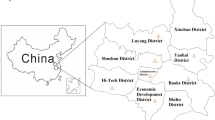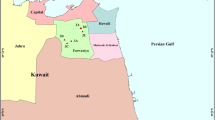Abstract
This study conducted a source apportionment and health risk estimation of ambient volatile organic compounds in Taoyuan and Zhongli (Taiwan) primary schools. In particular, principal component analysis followed by absolute principal component scores was used in order to identify and quantify the emission sources of volatile organic compounds. Health risk was determined on the basis of age group and gender using the method recommended by the United States Environmental Protection Agency, and Monte Carlo simulation was applied to analyze uncertainty and sensitivity. Results revealed that solvent usage in household product industries (56%) had the highest contribution of volatile organic compounds in Taoyuan and was followed by solvent usage in electronics manufacturing (27%) and oil refineries and storage leaks (17%). The main volatile organic compounds sources in Zhongli were vehicle emissions (48%) and liquefied petroleum gas/natural gas leakage (52%). Vehicle emissions and solvent usage in electronics manufacturing and household product industries were revealed as the primary sources of benzene, toluene, ethylbenzene, and xylenes, which were considered the compounds with high health risk for residents. The mean cumulative value of cancer risk ranged from 5.45 × 10−7 to 3.05 × 10−4, and the non-carcinogenic risk index for all age groups and genders was less than 1. The mean cumulative cancer risk was categorized as follows: below the limit recommended by United States Environmental Protection Agency, possible risk, probable risk, and definite risk. The magnitude of risks varied among age groups and between genders, and the variations in risk were statistically insignificant.





Similar content being viewed by others
References
Bakó-Biró Z, Clements-Croome DJ, Kochhar N, Awbi HB, Williams MJ (2012) Ventilation rates in schools and pupils’ performance. Build Environ 48:215–223. https://doi.org/10.1016/j.buildenv.2011.08.018
Blake DR, Rowland FS (1995) Urban leakage of liquefied petroleum gas and its impact on Mexico city air quality. Science 269:953–956. https://doi.org/10.1126/science.269.5226.953
Bono R, Scursatone E, Schilirò T, Gilli G (2003) Ambient air levels and occupational exposure to benzene Toluene, and Xylenes in Northwestern Italy. J Toxicol Environ Health Part A 66:519–531. https://doi.org/10.1080/15287390306357
Chang T-Y et al (2010) Characterization of volatile organic compounds in the vicinity of an optoelectronics industrial park in Taiwan. J Air Waste Manag Assoc 60:55–62. https://doi.org/10.3155/1047-3289.60.1.55
Chen C-L, Fang H-Y, Shu C-M (2006) Mapping and profile of emission sources for airborne volatile organic compounds from process regions at a petrochemical plant in Kaohsiung, Taiwan. J Air Waste Manag Assoc 56:824–833. https://doi.org/10.1080/10473289.2006.10464486
Cheng I, Xu X, Zhang L (2015) Overview of receptor-based source apportionment studies for speciated atmospheric mercury. Atmos Chem Phys 15:5493–5536. https://doi.org/10.5194/acpd-15-5493-2015
Cheng J-H, Hsieh M-J, Chen K-S (2017) Characteristics and source apportionment of ambient volatile organic compounds in a Science Park in Central Taiwan. Aerosol Air Qual Res 16:221–229. https://doi.org/10.4209/aaqr.2015.02.0114
Chiu K-H, Wu B-Z, Chang C-C, Sree U, Lo J-G (2005) Distribution of volatile organic compounds over a semiconductor Industrial Park in Taiwan environmental. Environ Sci Technol 39:973–983. https://doi.org/10.1021/es049110m
Dai H, Jing S, Wang H, Ma Y, Li L, Song W, Kan H (2017) VOC characteristics and inhalation health risks in newly renovated residences in Shanghai, China. Sci Total Environ 577:73–83. https://doi.org/10.1016/j.scitotenv.2016.10.071
Demirel G, Özden Ö, Döğeroğlu T, Gaga EO (2014) Personal exposure of primary school children to BTEX, NO2 and ozone in Eskişehir, Turkey: relationship with indoor/outdoor concentrations and risk assessment. Sc Total Environ 473–474:537–548. https://doi.org/10.1016/j.scitotenv.2013.12.034
Environmental Protection Agency (2000) Methyl ethyl ketone (2-butanone). EPA. http://www.epa.gov/sites/production/files/2016-09/documents/methyl-ethyl-ketone.pdf. Accessed 1 Feb 2018
Finlayson-Pitts B, Pitts J Jr (2000) Chemistry of the upper and lower atmosphere: theory, experiments and applications, 1st edn. Academic Press, Florida, pp 871–942
Gholizadeh MH, Melesse AM, Reddi L (2016) Water quality assessment and apportionment of pollution sources using APCS-MLR and PMF receptor modeling techniques in three major rivers of South Florida. Sci Total Environ 566–567:1552–1567. https://doi.org/10.1016/j.scitotenv.2016.06.046
Guo H, Wang T, Louie PKK (2004) Source apportionment of ambient non-methane hydrocarbons in Hong Kong. Environ Pollut 129:489–498. https://doi.org/10.1016/j.envpol.2003.11.006
Guo H, Wang T, Blake DR, Simpson IJ, Kwok YH, Li YS (2006) Regional and local contributions to ambient non-methane volatile organic compounds at a polluted rural/coastal site in Pearl River Delta, China. Atmos Environ 40:2345–2359. https://doi.org/10.1016/j.atmosenv.2005.12.011
Guo H, So KL, Simpson IJ, Barletta B, Meinardi S, Blake DR (2007) C1–C8 volatile organic compounds in the atmosphere of Hong Kong: overview of atmospheric processing and source apportionment. Atmos Environ 41:1456–1472. https://doi.org/10.1016/j.atmosenv.2006.10.011
Han X, Naeher LP (2006) A review of traffic-related air pollution exposure assessment studies in the developing world. Environ Int 32:106–120. https://doi.org/10.1016/j.envint.2005.05.020
Haney JT, Phillips T, Sielken RL, Valdez-Flores C (2015) Development of an inhalation unit risk factor for isoprene. Regul Toxicol Pharmacol 73:712–725. https://doi.org/10.1016/j.yrtph.2015.10.030
Ho KF, Lee SC, Guo H, Tsai WY (2004) Seasonal and diurnal variations of volatile organic compounds (VOCs) in the atmosphere of Hong Kong. Sci Total Environ 322:155–166. https://doi.org/10.1016/j.scitotenv.2003.10.004
Huang C-H, Chen K-S, Wang H-K (2012) Measurements and PCA/APCS analyses of volatile organic compounds in Kaohsiung municipal sewer systems, Southern Taiwan. Aerosol Air Qual Res 12:1315–1326. https://doi.org/10.4209/aaqr.2012.02.0035
IFC (2007) International Finance Corporation. Environmental, health, and safety guidelines for semiconductors and other electronics manufacturing. World Bank. http://www.ifc.org/wps/wcm/connect/bc321500488558d4817cd36a6515bb18/Final+-+Semiconductors+and+Other+Electronic+Mnfg.pdf?MOD=AJPERES. Accessed 1 Feb 2018
Indiana Department of Environmental Management (2018) Dichloromethane. IDEM Indianapolis. http://www.in.gov/idem/toxic/files/studies_toxwatch_dichloromethane.pdf. Accessed 1 Feb 2018
Inoue K, Nomura M (2016) The neuropathology of drug addictions and substance misuse. Elsevier. https://doi.org/10.1016/b978-0-12-800634-4.00063-9
IRIS (2017) Integrated risk information system USEPA. http://www.epa.gov/iris. Accessed 18 May 2017
Jung J-H, Choi B-W, Kim M-H, Baek S-O, Lee G-W, Shon B-H (2012) The characteristics of the appearance and health risks of volatile organic compounds in industrial (Pohang, Ulsan) and non-industrial (Gyeongju) areas. Environ Health Toxicol 27:e2012012. https://doi.org/10.5620/eht.2012.27.e2012012
Madureira J, Paciência I, Rufo J, Severo M, Ramos E, Barros H, de Oliveira Fernandes E (2016) Source apportionment of CO2, PM10 and VOCs levels and health risk assessment in naturally ventilated primary schools in Porto, Portugal. Build Environ 96:198–205. https://doi.org/10.1016/j.buildenv.2015.11.031
Masih A, Lall AS, Taneja A, Singhvi R (2016) Inhalation exposure and related health risks of BTEX in ambient air at different microenvironments of a terai zone in north India. Atmos Environ 147:55–66. https://doi.org/10.1016/j.atmosenv.2016.09.067
Ministry of Health and Welfare (2008) Exposure factors for general population in Taiwan. Health Promotion Administration MOHW, Taipei
Miri M et al (2016) Investigation of outdoor BTEX: concentration, variations, sources, spatial distribution, and risk assessment. Chemosphere 163:601–609. https://doi.org/10.1016/j.chemosphere.2016.07.088
Mohai P, Kweon BS, Lee S, Ard K (2011) Air pollution around schools is linked to poorer student health and academic performance. Health Aff 30:852–862. https://doi.org/10.1377/hlthaff.2011.0077
Pallant J (2013) SPSS survival manual: a step by step guide to data analysis using SPSS for windows, 3rd edn. Open University Press, Bekshire
Sexton K, Linder SH, Marko D, Bethel H, Lupo PJ (2007) Comparative assessment of air pollution-related health risks in Houston. Environ Health Perspect. https://doi.org/10.1289/ehp.10043
Sharma UK, Kajii Y, Akimoto H (2000) Characterization of NMHCs in downtown urban center Kathmandu and rural site Nagarkot in Nepal. Atmos Environ 34:3297–3307. https://doi.org/10.1016/s1352-2310(99)00485-9
Singh D, Kumar A, Kumar K, Singh B, Mina U, Singh BB, Jain VK (2016) Statistical modeling of O3, NOx, CO, PM2.5, VOCs and noise levels in commercial complex and associated health risk assessment in an academic institution. Sci Total Environ 572:586–594. https://doi.org/10.1016/j.scitotenv.2016.08.086
Sofuoglu SC, Aslan G, Inal F, Sofuoglu A (2011) An assessment of indoor air concentrations and health risks of volatile organic compounds in three primary schools. Int J Hyg Environ Health 214:36–46. https://doi.org/10.1016/j.ijheh.2010.08.008
Twardella D et al (2012) Effect of classroom air quality on students’ concentration: results of a cluster-randomized cross-over experimental study. Indoor Air 22:378–387. https://doi.org/10.1111/j.1600-0668.2012.00774.x
Wang Y-C, Lin C, Lin Y-K, Wang Y-F, Weng W-H, Kuo Y-M (2016) Characteristics and determinants of ambient volatile organic compounds in primary schools. Environ Sci Process Impacts 18:1458–1468. https://doi.org/10.1039/c6em00491a
Watson JG, Chow JC, Fujita EM (2001) Review of volatile organic compound source apportionment by chemical mass balance. Atmos Environ 35:1567–1584. https://doi.org/10.1016/s1352-2310(00)0046-1
Zhou J, Bai Z, Zhang N (2011) Health risk assessment of personal exposure to volatile organic compounds in Tianjin, China. Epidemiology 22:S189. https://doi.org/10.1097/01.ede.0000392261.49476.6c
Acknowledgments
This study was supported by National Science Council and Ministry of Science and Technology (NSC 99-2221-E-033-052, NSC 102-2621-M-033-001, MOST 103-2621-M-033-001, and MOST 103-2633-M-033-002) of Taiwan.
Author information
Authors and Affiliations
Corresponding author
Ethics declarations
Conflict of interest
The authors declare that they have no conflict of interest
Additional information
Editorial responsibility: Agnieszka Galuszka.
Electronic supplementary material
Below is the link to the electronic supplementary material.
Rights and permissions
About this article
Cite this article
Widiana, D.R., Wang, Y.C., You, S.J. et al. Source apportionment and health risk assessment of ambient volatile organic compounds in primary schools in Northern Taiwan. Int. J. Environ. Sci. Technol. 16, 6175–6188 (2019). https://doi.org/10.1007/s13762-018-2157-1
Received:
Revised:
Accepted:
Published:
Issue Date:
DOI: https://doi.org/10.1007/s13762-018-2157-1




